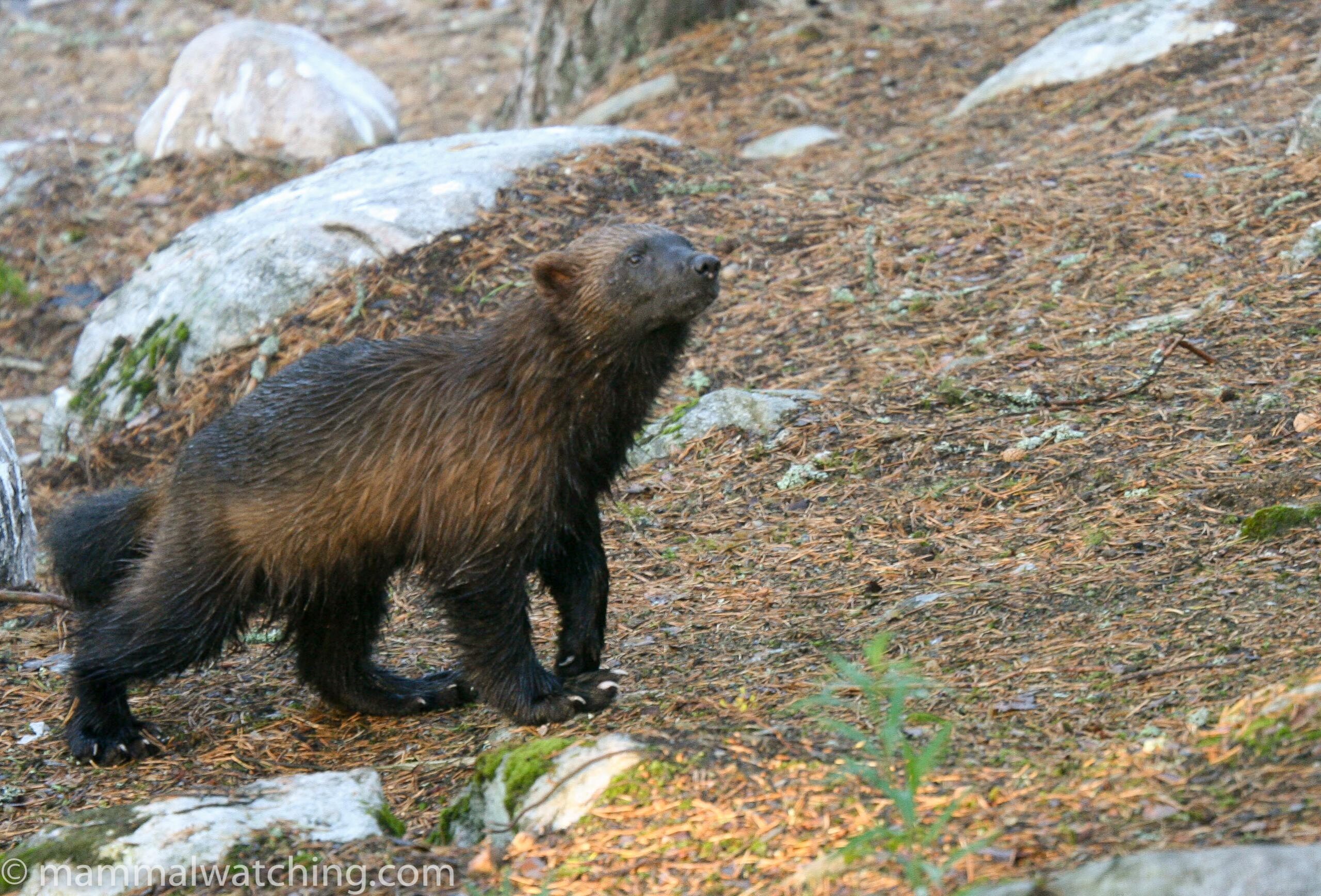
Finland
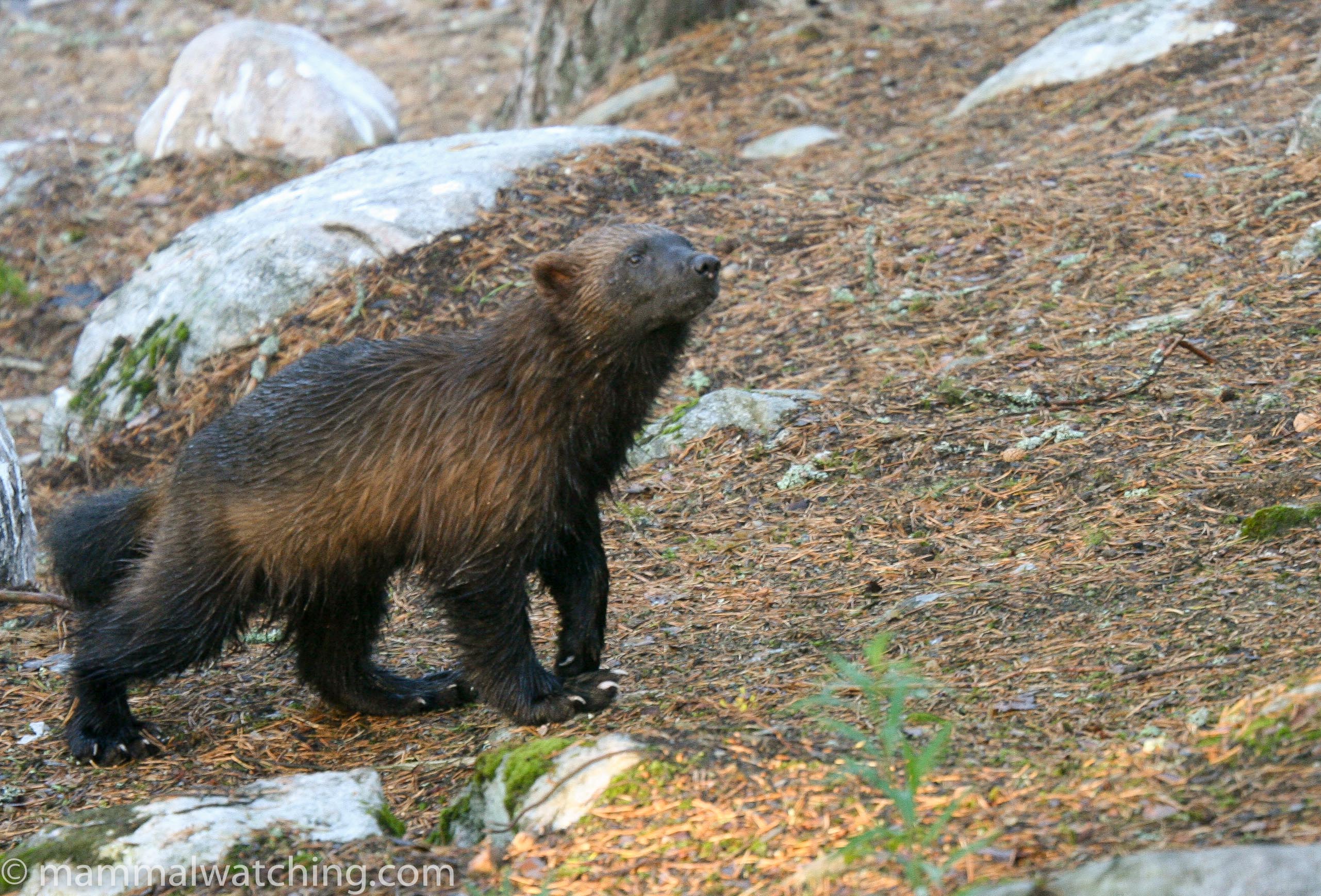
Wolverine, Gulo gulo
In 2006 I began to hear rumours that Finland, famous for its Reindeer, saunas and rally drivers, was also emerging as the World Wolverine Watching Capital. I have long thought that Wolverines are a fabulous mammal – and they’ve been near the top of my “to see list” since long before the X-Men movies. In the USA and Canada they are immensely hard to stumble across. Outdoors people I have spoken to in the Yukon and Alaska reckoned they see about one a year on average. But then I heard about Finland.
For several years a few Finnish photographers have been leaving animal and fish carcasses near hides, as a way to assist bear and wolf photography. A bit of a tourist industry has sprung up around the bear watching in particular (See Wild Brown Bear for example). But Wolverines have also become regular visitors to some hides. And in March 2007 I spent a weekend in Finland trying to see one. I failed, but I esolved to try again and returned in July 2008.
Although Finland was not a super cheap country to travel in, it was a bargain hunter’s paradise compared to Norway. And the accommodation in rural areas was very affordable (by European standards not just Scandinavian).
Wolverines
I first became fascinated by Wolverines when I was in Wolverine country for the first time during a trip through the Rockies in 1992. I remember watching a breakfast tv show piece in Colorado about a guy with a pet Wolverine. I was smitten. And so, ever since, whenever I have been anywhere with even the remotest chance of seeing one I have asked “and how often do you see Wolverines?”. The answer always dashed my hopes, usually varying from “once a year maybe” to “never”. Nor has anyone offered any tips on where to look for them. Wolverines have large home ranges and perpetually wander.
Where and When to Go
There are thought to be up to 120 Wolverines living in Finland. Although they are scattered across the centre and north of the country, the best areas to look seem to be around Kumho and Lieksa. There are a a few hides in these areas. Primarily designed for photography, they have been baited with pig, elk or fish carcasses for several years and Wolverines, Bears and Wolves are regular visitors to some of them.

There are also a network of people who can help. They earn a living through wildlife tourism including photography through guiding. Each seems to own several hides. Eero Kemila, my guide in 2007, described the industry as a Turkish bazaar, with each guide referring clients to others if they are busy and using one another’s hides depending on what animal you want to see and when you are there. Although we didn’t see a Wolverine in 2007 I have no reason to regret my choice of Eero. He was good company and knowledgeable, spoke excellent English and tried hard to find the animals.
After talking to a few people in Finland I am still unsure of the optimum time of year to visit for Wolverines. The two factors at play are the level and pattern of animal activity and the available daylight, which is pretty limited in the winter months. Wolverines are active day and night, but are more active in the evenings.
It seems the best season for Wolverine watching begins in late February, and continues to mid Augus, when the hunting season begins and there is too much disturbance to see the animals. My guess is the very best period to look would have to be mid May through July when there would be nearly 24 hour daylight. This opinion has been confirmed by others. Although the Wolverines might not be any more active or common then, you would have the daylight to mount a 24 hour watch to increase the chances of seeing one. Brown Bears of course hibernate over the winter and don’t emerge until April.
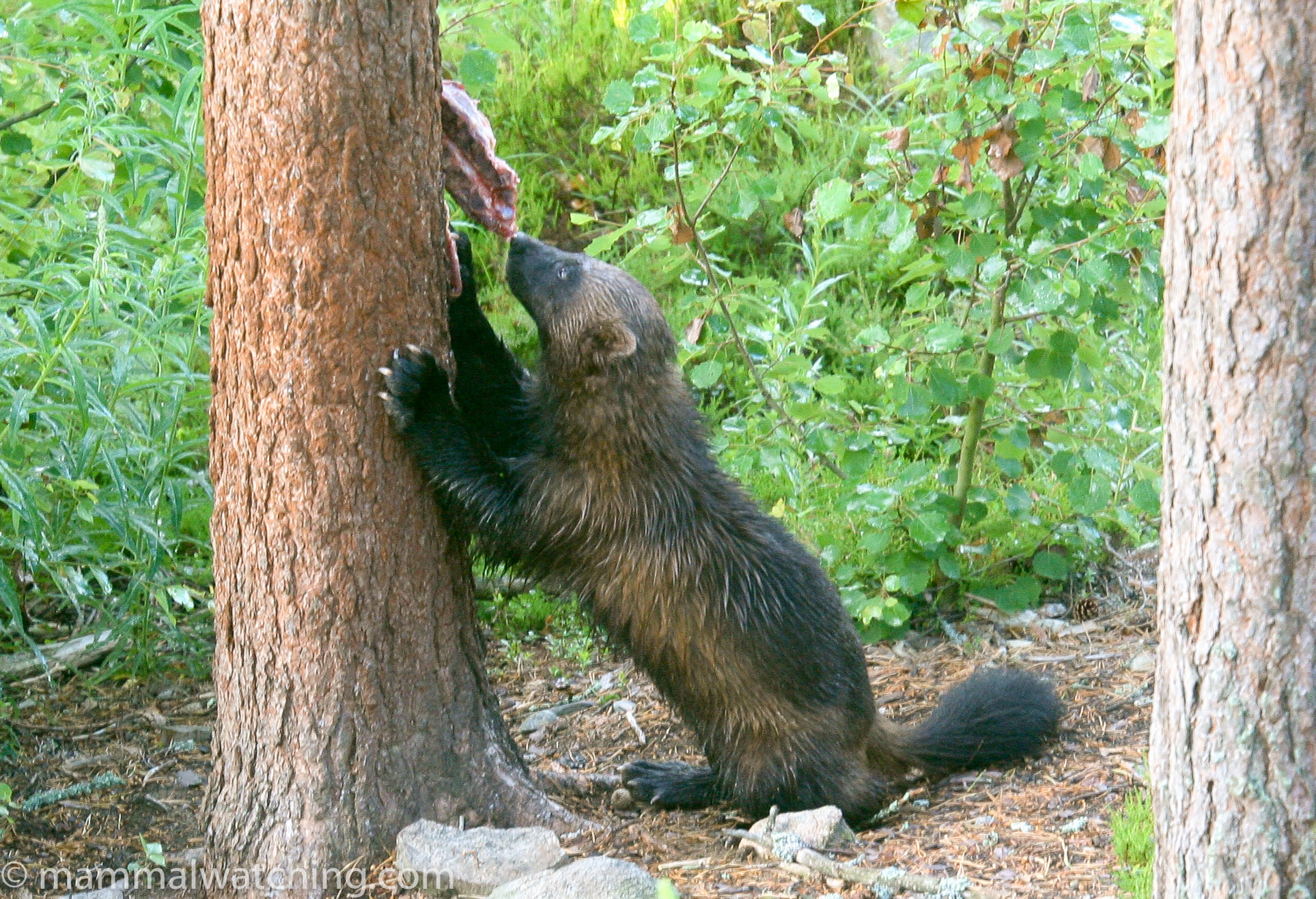
Wolverine, Gulo gulo
Lieksa
In the early 2000s a handful of wildlife watching places sprung up along Finland’s eastern border. Originally aimed at attracting Brown Bears, several have added other species to the mammal watching menu including Flying Squirrels, Wolves and Wolverines. For my second trip to Finland, in July 2008, I decided to go to Era Eero, a lodge near Lieksa that seemed to have a good success rate for Wolverines. A week before I arrived a mother with three kits had been visiting every night, with two other animals regular visitors. I was feeling quietly confident. Overly confident it turned out.
Era Eero claimed to be the only lodge in Finland where the “big 4” – Bears, Wolverines, Wolves and Lynxes have been seen. The latter two are rare, but a Lynx that visited in May stayed around for almost 2 weeks. If only I had known….
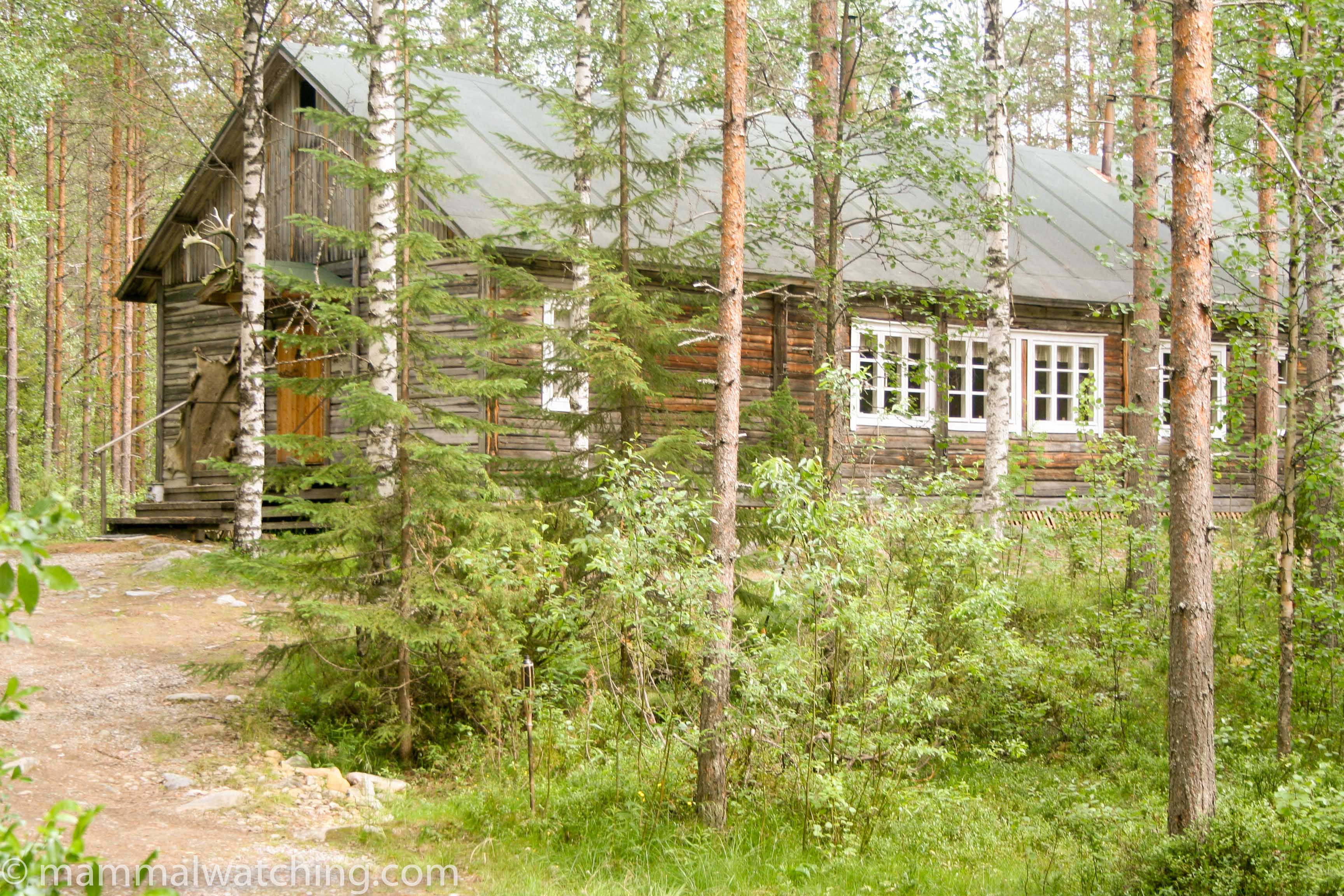
Era Eero Lodge
The lodge had been run for wildlife watching since 2003. Eero Kortelainen, the owner, grew up in the area and likes to showcase traditional rural life. And so there is a sauna (of course!) and no electricity (though that wasn’t a problem because they could arrange to charge my phone). The wildlife hide is about 6km from the lodge and overlooks a lake and a primary-forested slope. Eero set bait all around it.
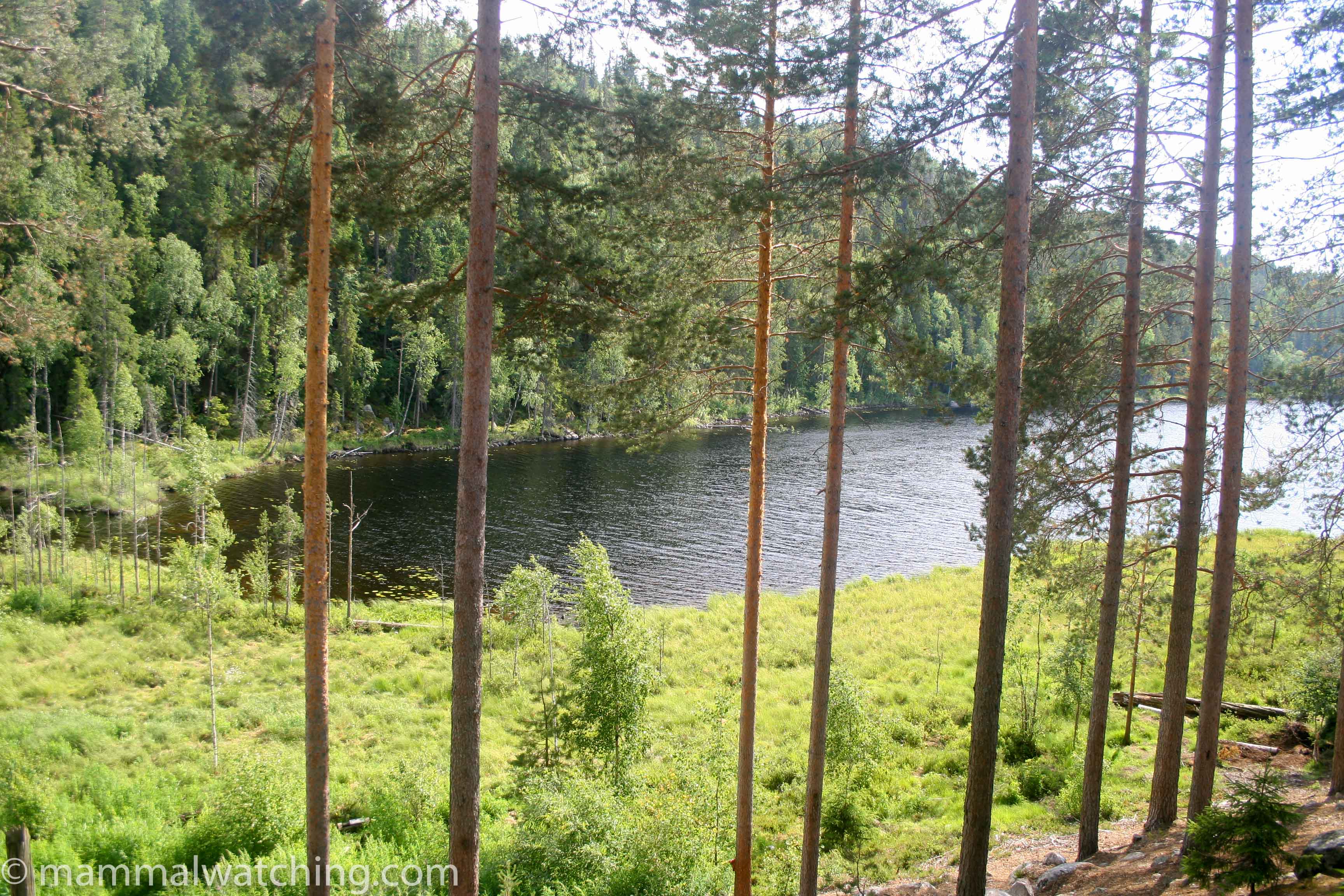
The view from the hide
Era Eero is a small lodge and so they cater to individuals well. I dealt with Juhani Heiskanen, the lodge’s wildlife guide, who was extremely helpful and speaks perfect English. Not only did he look after me at the lodge but he went out of his way to find people who could find me species beyond Wolverines.
The usual routine is to travel from the lodge to the hide at about 4 p.m. and leave at 6 a.m. the next day. The hide is very comfortable – reclining seats, and camp beds, an inside toilet and more. They also have a powerful microphone set up so you can hear most rustles for over 100 metres. A German film crew were set up in a smaller hide next door, making a documentary on Wolverines. Apparently Wolverines had come for the past 9 consecutive nights. Bears had been less regular but were also seen or heard most nights. My confidence was intact.
The first night was long and frustrating. Juhani expected a Wolverine would come before 8 p.m. By 11.30 the light was fading into the twilight of mid summer but we stayed awake. There was daylight again at 2.30 a.m. Still nothing. We left at 7.30 a.m. – tired and emotional. Both Juhani and Eero were surprised at the lack of anything mammalian and I was touched by their genuine disappointment.
Back at the lodge I slept and set some small mammal traps before lunch. Then back to the hide: this time I was staying there alone. My confidence, along with my watching companions, had deserted me.
The night was long and slow, punctuated by coffee and donuts. At 5 a.m. I was starting to pack up my gear, convinced that I was cursed never to see a Wolverine. I glanced out of the window one last time at 5.30 … and a Wolverine was in front of me. She stayed for an hour, moving around the various bait stations and through the swampy area in front of the hide. What a fabulous animal! What a wonderful hour! What sweet relief! I’m glad it took so long to arrive … it made the moment all the more special.
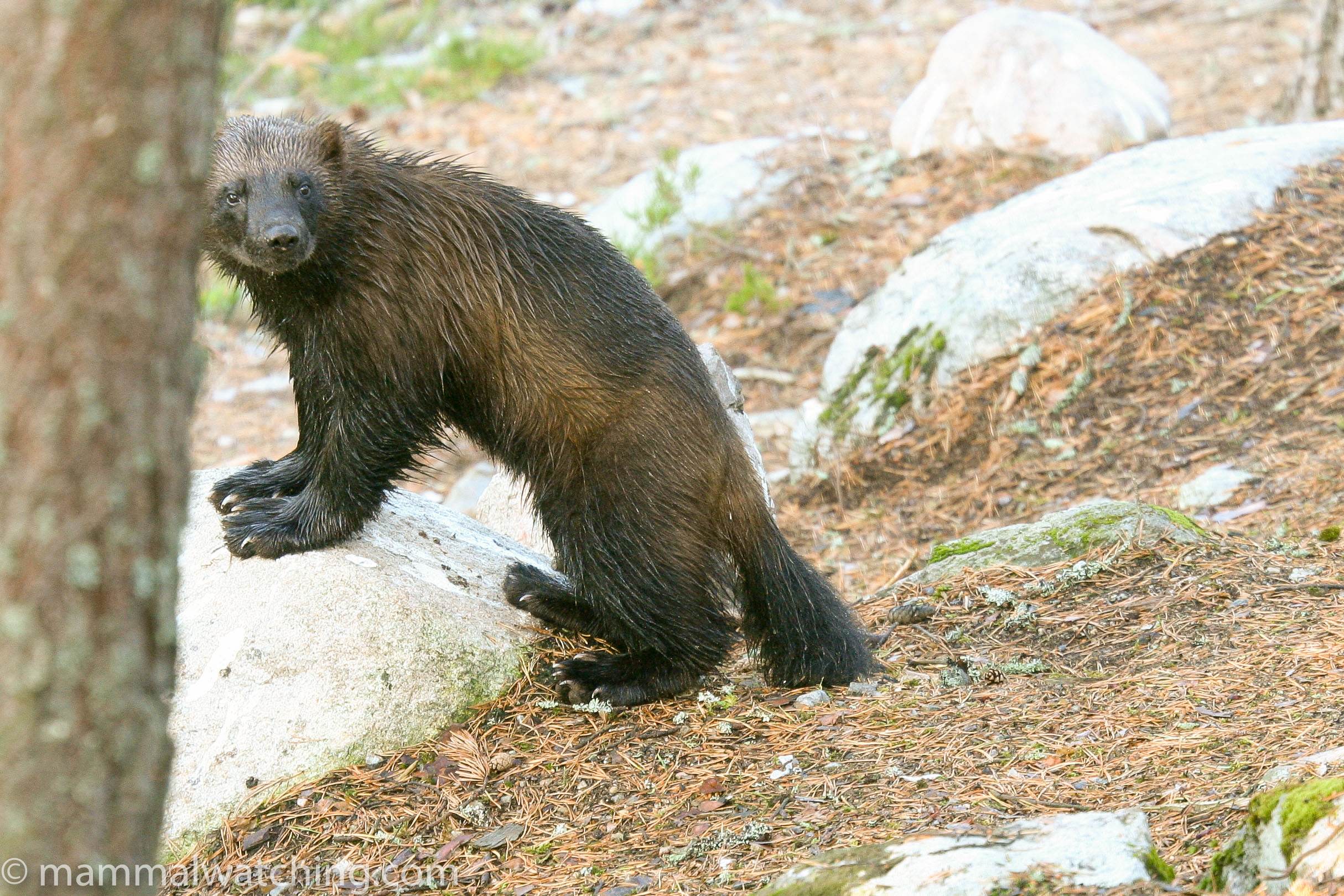
Wolverine, Gulo gulo
I guess it it possible that there are better places in the world to see Wolverines. But I haven’t heard about them.
Janakkala
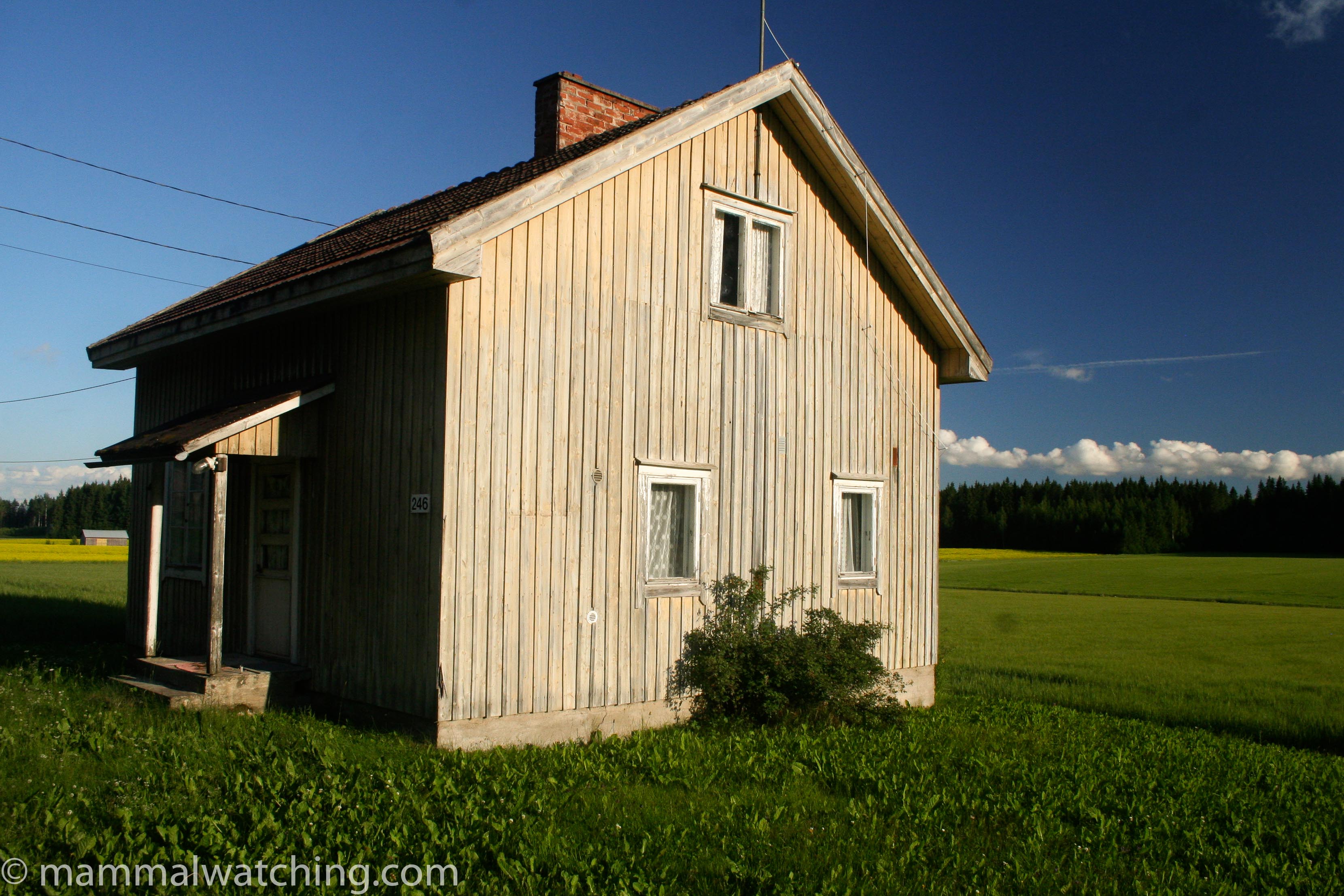
After my Wolverine watching I went back towards Helsinki and met up with Petteri Vihervaara, a biologist and bat worker. Petteri is available as a guide when he isn’t working and seemed very knowledgeable about Finnish mammals. That night he was radio tracking some Brandt’s bats. We met at the small town of Janakkala and spent a fun evening catching Brandt’s Bats and unsuccessfully trying to catch some Northern Bats.
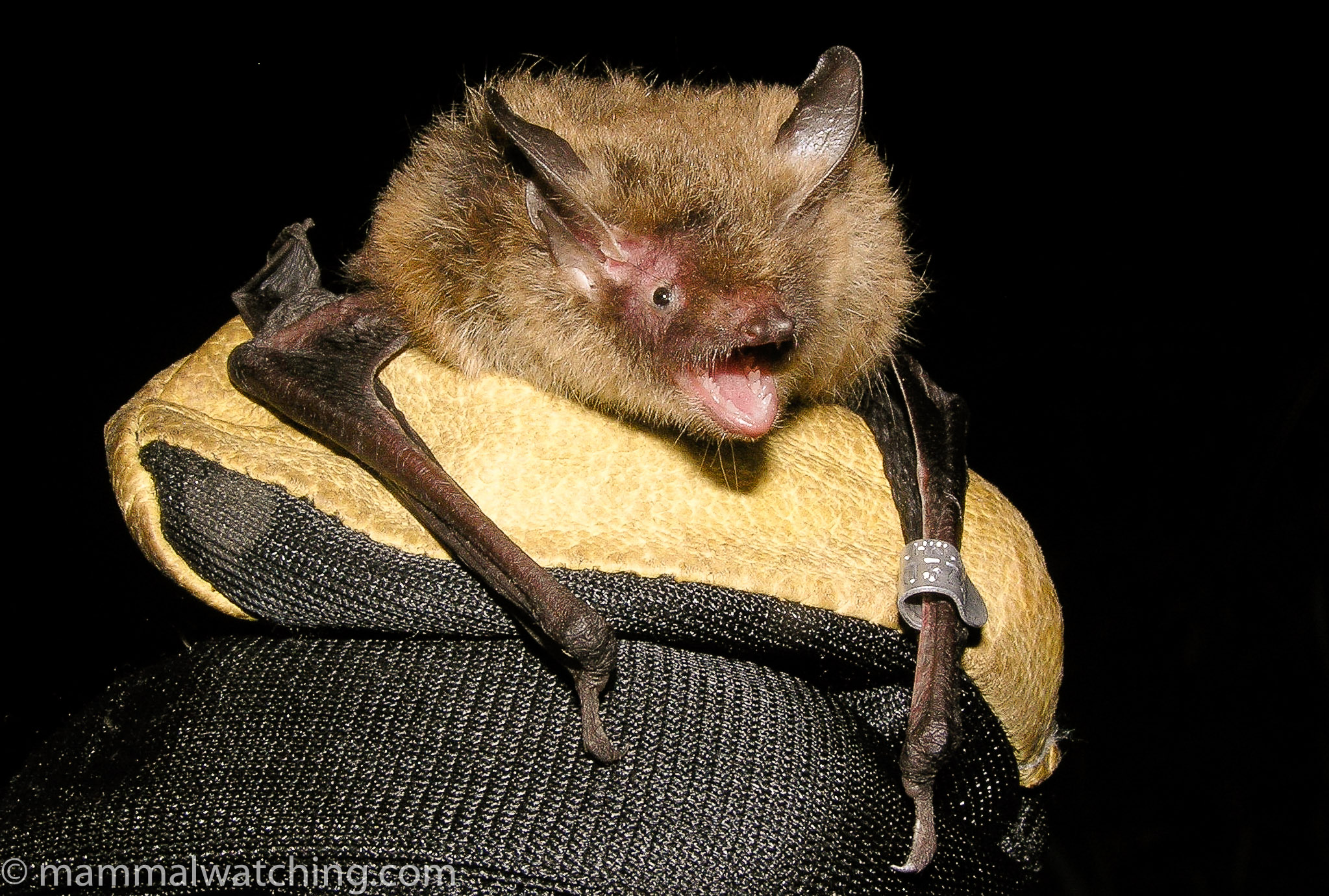
Brandt’s Bat, Myotis brandtii
Catching Northern Bats is fun but difficult. The catching technique is unusual … walking down a forest road with nets slung between 10 metres long fishing poles. If anyone had seen us then I reckon the police or, more likely, NASA would have been called. Though we saw a few, and made made unsuccessful swoops for them, we did not manage to grab any.
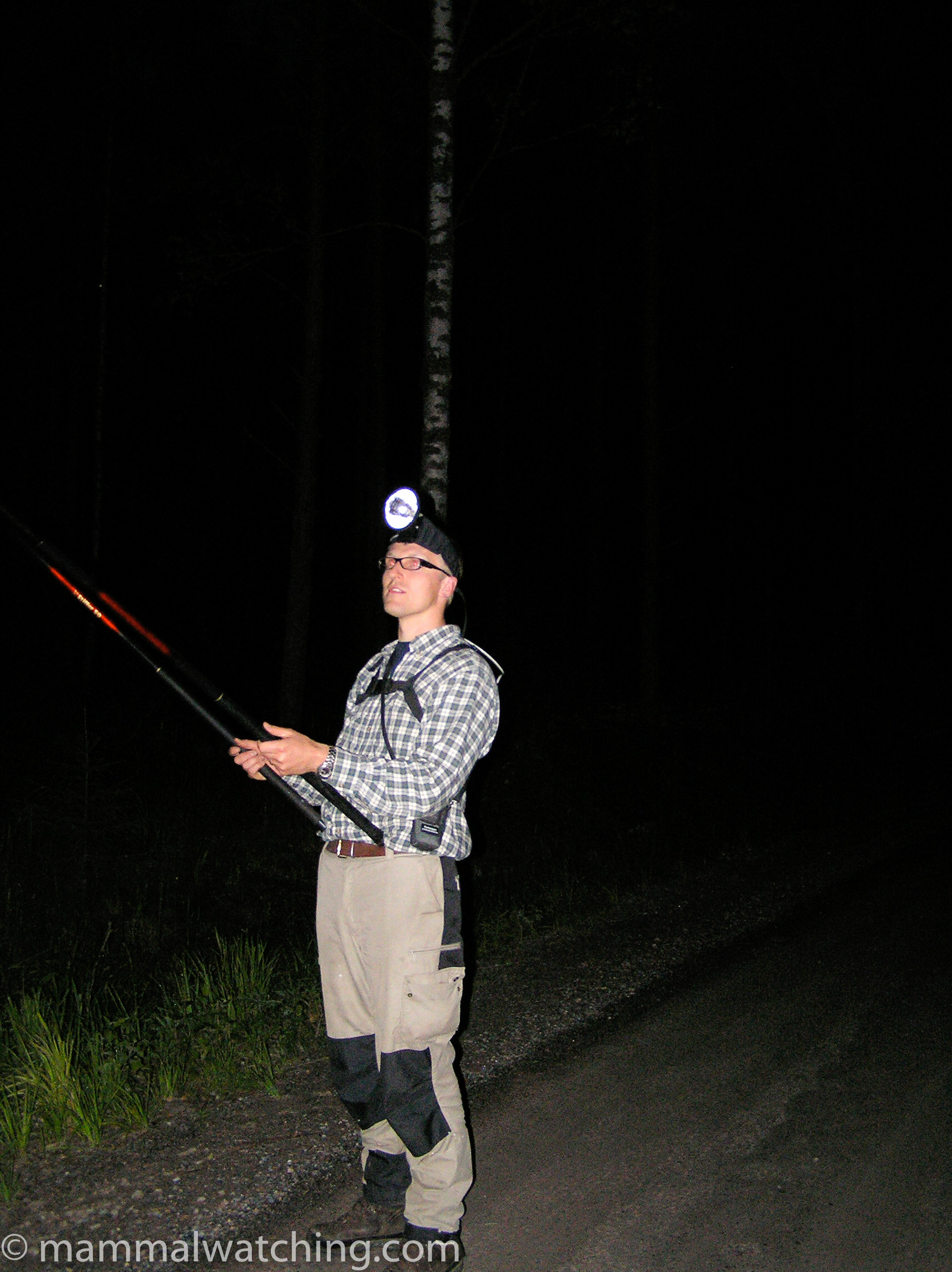
Brandt’s Bat catcher … or the Thing from Planet X?
I set a few small mammal traps in the forest and – following Petteri’s advice to bait them with carrots and apple, I caught my first ever Field Vole, along with the usual Bank Voles. We also saw several Brown Hares, a Northern Water Vole, Daubenton’s Bats and a Red Squirrel in the forest. Mink and Raccoon Dogs are apparently plentiful.
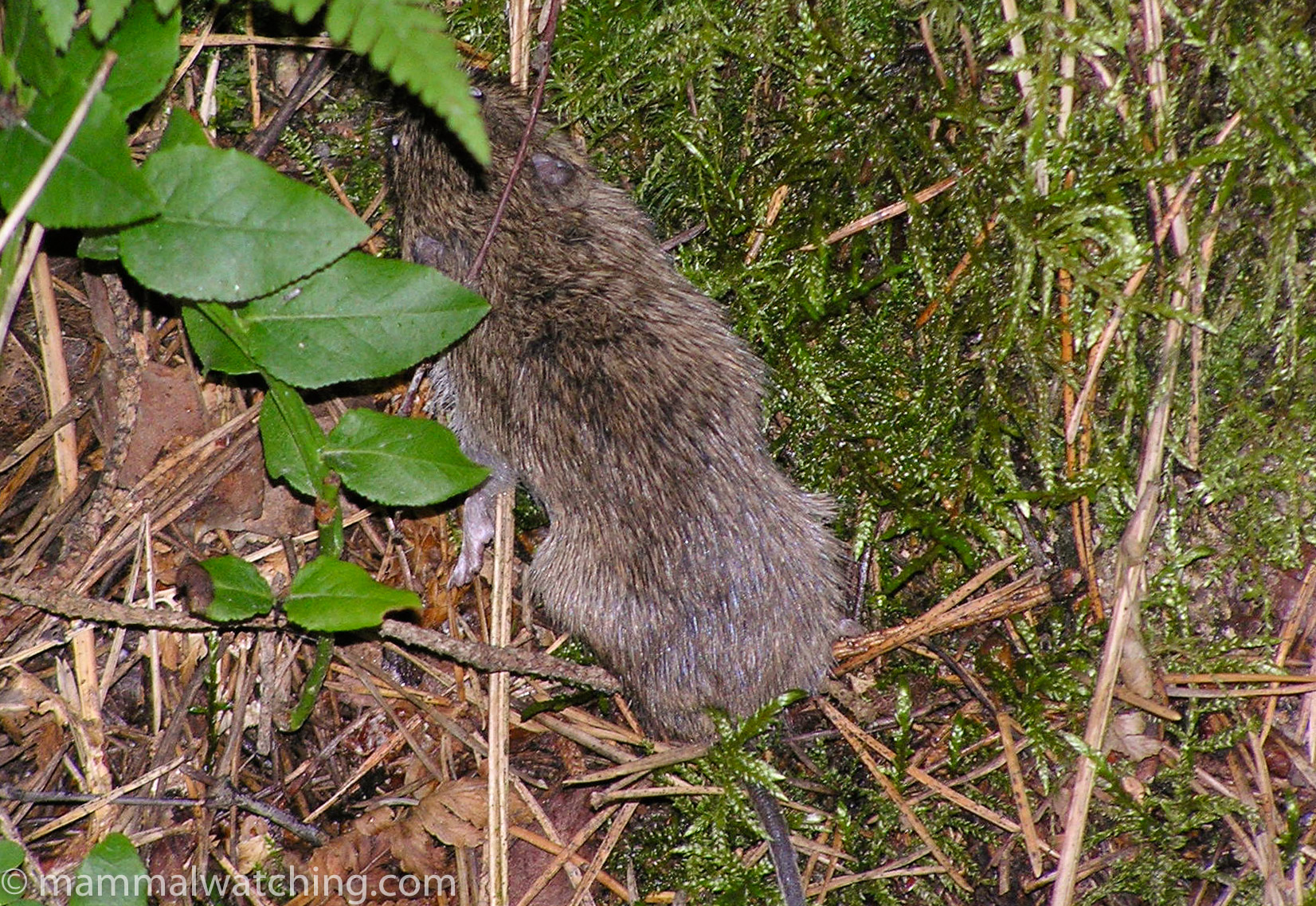
Field Vole, Microtus agrestis
Kuopio
I spent an evening looking for Flying Squirrels around Kuopio. They are not uncommon but are hard to find in the summer. Early spring is the best time when you can find their yellow droppings on the snow and when there is enough darkness to spotlight. They have large eyes so should have reasonable eyeshine.
Oulu
I first visited Finland in March 2007. Eero Kemila, my guide, met me at Oulu airport. The temperature was just below freezing but that was about 30 degrees warmer than it had been a fortnight before. I spent the first night in an “artist’s residence” near Eero’s place at Vaala about an hour out of Oulu. This forest cottage cost just 25 euros for the night.
The next day started with breakfast at Eero’s place (featuring a Red Squirrel on his bird feeder). After which we went to Kumho and met with a Finnish nature film maker friend of Eero’s who owned the hides that we were going to use first. We saw a herd of Reindeer and a Capercaillie at the side of the road.

Reindeer, Rangifer tarandus fennicus
After several hours of faffing around, including a trip to some government offices to get a permit to enter the buffer zone along the Russian border, we made it to the hide by 1 p.m. There were fresh Wolverine tracks on the 15 minute trail to the hide. The snow was still deep and we had to use snowshoes. However it was raining which did not bode well for Wolverine watching as they don’t like moving when the snow is soft.
The hide was cramped to say the least (about 3m x 1m) but the amount of Wolverine tracks around the pile of dead pigs suggested that the discomfort was worth it. Later in the afternoon the sun came out and a Goshawk turned up. But no Wolverine. We left about 6.30 p.m. as the light was fading. Eero remained confident that we would succeed the next day.
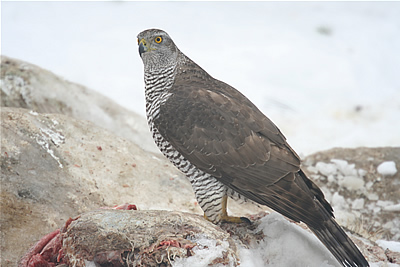
Goshawk
I spent that night in a cabin in the forest close to the Russian border about 60 km south east of Kumho. The Elliott traps I set in the woodshed had a few Bank Voles the next morning, with a narrower and more pronounced band of red band of fur on the back than those I an used to seeing in Western Europe (so much so that I thought they were Grey-sided Voles to begin with).
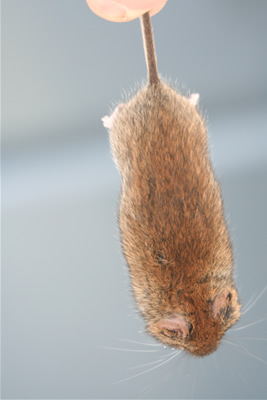
Bank Vole, Clethrionomys glareolus
And then it was back to the hide. We arrived at 7 a.m., a couple of hours later than we could have arrived (the sun comes up about 5). The night had been cold and the snow was much firmer than the day before. This hide was also larger than the yesterday’s (at least 4 metres long) and kitted out for photography rather than film making which was a bonus. A fresh Elk carcass had been delivered the afternoon before, and there were Wolverine tracks across the the trail the Skidoo had made when it delivered the deer. Both Eero and I were optimistic. Eero explained that the last person to use the hide and been a Finnish photographer a couple of weeks before me. He had spent two days there and seen a Wolverine (or Wolverines) several times on both days.
Two hours, 100 games of brick-buster on my phone, and 1 kg of biscuits later we were Wolverineless. I was less confident. We decided to spend the night in the hide. There was just about enough light to see what was going on around the deer carcass until about 8 p.m. and after that the starlight and reflection from the snow was enough to spot movement, provided I put my head out of the window. I woke up every hour or so to check through the night and began watching again full time at daybreak at 4 a.m.
We left at 9 a.m. Wolverineless. But there were fresh tracks (less than an hour old) crossing the road that took us the 5 km back to the cabin. I am not sure if this heightened or lessened my disappointment! Perhaps the delivery of a fresh carcass the day before I arrived was a mistake. Wolverines are notoriously skittish and the disturbance may have spooked them.
On reflection I was overly confident about my chances for success this weekend and, especially given our very limited time in the field, we should probably have tried harder earlier on. Next time I would know better.
There are several other animals that one can apparently see quite easily in the summer in this area including Flying Squirrels, Water Shrews and Northern Bats. On the way back to the airport we stopped near Eero’s place to see Ermili (“he” used to be called mily), a wild Grey Hawk Owl that had been hanging around for two months and developed a taste for being hand-fed rodents. That was kind of fun.
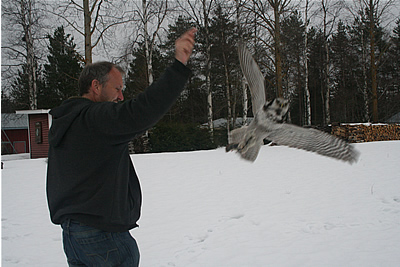
Feeding Ermili the Hawk Owl
Community Reports
Saimaa Ringed Seal, 2024: Jan Ebr’s account of a 5 day canoe trip in search of Ringed Seals.
Wolverines, 2022: Royle Safaris‘ combined report of 2 trips with 9 mammals including Wolverine, Wolf and Brown Bear.
Finland, 2022: Wise Birding, 5 days & 7 species including Wolverine, Brown Bear and Ringed Seal.
Wolverines, 2021: Tomer Ben-Yehuda’s brief Wolverine watching trip.
Finland, 2021: Janco van Gelderen, 1 week & 15 species including Wolf, Brown Bear and Wolverine.
Forest Reindeer, Kuhmo, 2019: Jens Krause’s note on finding Forest Reindeer.
Finland, 2019: Naturetrek, 8 days & 10 species including Ringed Seal, Wolf and Wolverine.
Finland Competitive Mammalwatching, May 2019: Olli Haukkovaara’s entertaining piece about the annual competition to see the most mammals in a year with species already including Lynx and House Mouse.
Kuikka Base Camp and Era Eero, 2018: Stuart Chapman, 1 week and 9 species including Wolf, Wolverine and Brown Bear.
Finland, 2017: Samuel Marlin, 7 species including Wolverine, Wolf, Brown Bear and Stoat.
Lieksa, 2017: Mattia Altieri, 5 days & 6 species including Wolverine, Wolf and Brown Bear.
Finland, 2015: Sjef Ollers, 6 days & 8 species including Wolf, Wolverine, Brown Bear and Reindeer.
Finland, 2014: Simon Feys, 5 days & 9 species including Ringed Seal, Flying Squirrel and Pine Marten.
Finland, 2014: Jan Kelchtermans, 5 days with mammals including Brown Bear, Flying Squirrel and Ringed Seal.
Finland, 2014: John Wright, 4 days & 6 species including Wolverine, Brown Bears and a Grey-sided Vole.
Finland, 2014: Richard Webb, 4 days & 4 species including Wolverine and Brown Bear.
Finland, 2013: Jan Kelchtermans, 5 days & 7 species including Moose, Wolverine, Saimaa Ringed Seal, Reindeer and Brown Bear.
Finland, 2013: John Wright, 5 days & 5 species including Reindeer and Wolverine.
Finland, 2013: Sjef Ollers, 10 days & 12 species including Brown Bear, Wolf and Wolverine.
Finland, May 2012: Royle Safaris, 5 days & 4 species including Wolverine.
Finland, April 2012: Royle Safaris, 5 days & 6 species including Wolverine.
Finland, 2012: Uffe Gjøl Sørensen, 9 days & 18 species including Flying Squirrel, Wolf, Wolverine, Bear, Ringed Seals and Reindeer.
Estonia, Finland and Arctic Norway, 2012: Dominique Brugiere, 3 weeks & 17 species plus another 3 dead, including Wolverine, Brown Bear, Wolf, and Reindeer.
Finland, 2011: Mark Hows, 16 days & 26 species including Wolverine and lots of rodents.
Finland, 2011: Steve Morgan, 5 nights and lots of Wolverine watching, plus Brown Bears and a Wolf.
Finland, 2009: Derek Shingles, 2 weeks and 7 species including a Saimaa Ringed Seal and Raccoon Dogs.
Finland, 2007: Michel Gervais, 4 weeks and 10 live mammals plus 4 more squashed (including a Wolverine)
Also See
RFI: Flying Squirrels May 2020
RFI: Predator watching in Finland May 2020
Some tips (in the comment from Elina Enho) on seeing Saimaa Seals in Linnansaari National Park.
Resources
In 2009 John Dixon visited Finland and saw Wolverines easily a bear hide run by Metsanvaki Oy/Forest Folk Ltd. Contact details are variable: e-mail metsanvaki@bomba.fi tel +358 (0) 13 687 2228 or Olli direct on olli@metsanvaki.fi tel +358 (0) 50 060 1915.
1 Comment
Leave a Reply
You must be logged in to post a comment.


Olli Haukkovaara
On what comes to Reindeer you saw near Kuhmo, it’s actually Finnish Forest Reindeer (Rangifer tarandus fennicus). Congrats! Reindeer itself refers to those domestic reindeers that inhabitate whole northern Finland – which are really not wild animals.